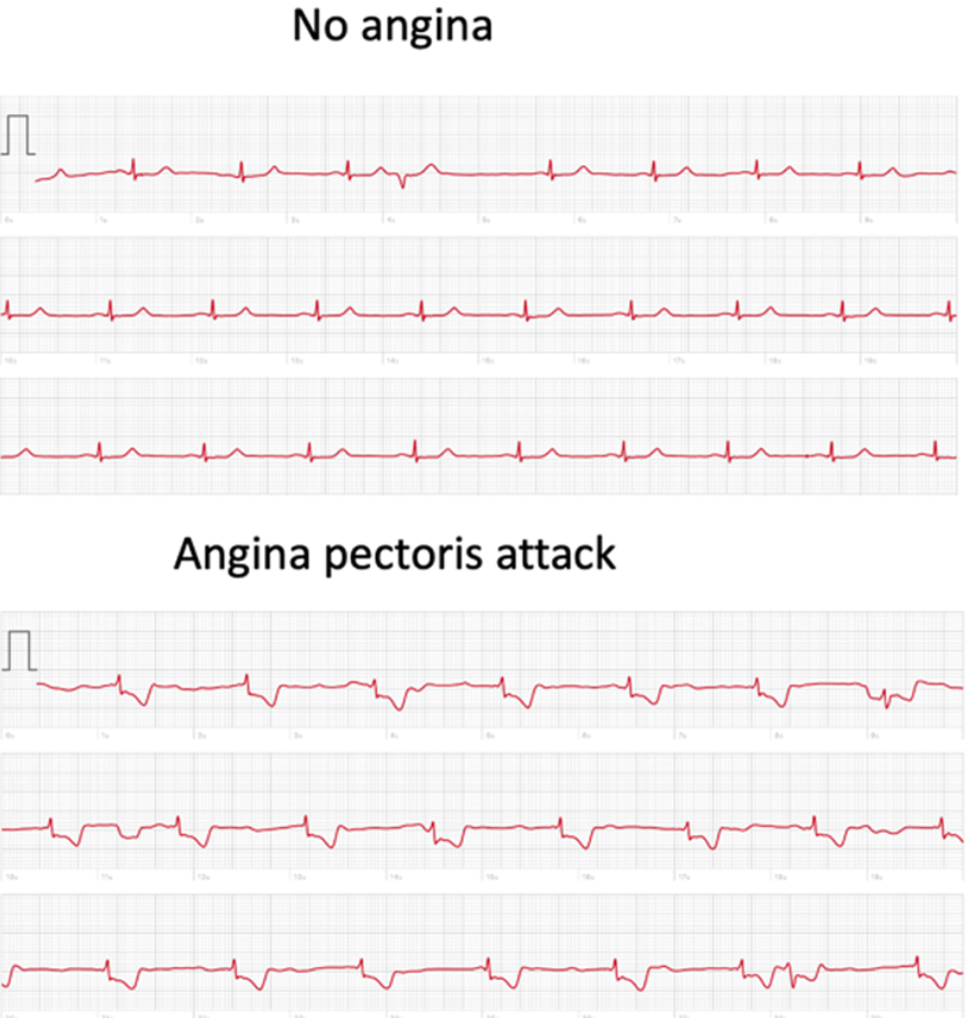The Apple Watch and the EKG.
-
Frankly, I'm surprised. I've always thought that the EKG function on the Apple Watch is useful for determining abnormal cardiac rhythms. Specifically, it will detect PVCs (premature ventricular contractions) and AFib (Atrial Fibrillation).
However, this journal has a case report of a woman whose Apple Watch detected myocardial ischemia (lack of blood flow to the cardiac muscle) when she was experiencing chest pain.
The EKG done by the Apple Watch is simplistic, only showing one lead (lead 1) of a standard 12-lead EKG. Nevertheless the changes in this woman's EKG on lead 1 are striking and diagnostic.
https://academic.oup.com/eurheartj/advance-article/doi/10.1093/eurheartj/ehaa290/5826159#apl
An 80-year-old lady with a work history as engineer presented with typical angina symptoms Canadian Cardiovascular Society Class III in our chest pain unit (CPU). She also complained of two episodes of praesyncopy. There reported novegetative symptoms. Previous his- tory included a diagnosis of arterial hypertension, paroxysmal atrial fibrillation, and an episode of pulmonary embolism 2 years ago. Her current medication included aspirin, telmisartan, nebivolol, atorvastatin, and the organic nitrate pentaerythritol tetranitrate (PETN). The initial 12-channel ECG revealed no evidence for ischaemia. High-sensitive troponin I was also nega- tive. The patient also complained about previous frequent episodes of ectopic beats which were recorded with her Apple watch. Further, Apple watch recordings included tracings with marked ST-segment depression (Panel). Based on this evidence of ischaemia, further diagnos- tic in the CPU was omitted and the patient was transferred to the catheterization laboratory, where a left main stem stenosis and a left ante- rior descending/diagonal bifurcation lesion (Panel). Accordingly, the patient was treated with coronary artery stenting and left the hospital a day later.
The development of smart technologies paves the way for new diagnostic possibilities. In the case of the Apple watch, after the mobile application is installed, the records an ECG when a finger is placed on the watch’s digital crown. A 30-s tracing is stored in a PDF file that can be retrieved from the application.
.
Thus, the Apple watch may be used not only to detect atrial fibrillation or atrioventricular-conduction disturbances but also to detect myocardial ischaemia.
An apple a day may keep myocardial infarction away.Her EKG is strikingly different:

-
Frankly, I'm surprised. I've always thought that the EKG function on the Apple Watch is useful for determining abnormal cardiac rhythms. Specifically, it will detect PVCs (premature ventricular contractions) and AFib (Atrial Fibrillation).
However, this journal has a case report of a woman whose Apple Watch detected myocardial ischemia (lack of blood flow to the cardiac muscle) when she was experiencing chest pain.
The EKG done by the Apple Watch is simplistic, only showing one lead (lead 1) of a standard 12-lead EKG. Nevertheless the changes in this woman's EKG on lead 1 are striking and diagnostic.
https://academic.oup.com/eurheartj/advance-article/doi/10.1093/eurheartj/ehaa290/5826159#apl
An 80-year-old lady with a work history as engineer presented with typical angina symptoms Canadian Cardiovascular Society Class III in our chest pain unit (CPU). She also complained of two episodes of praesyncopy. There reported novegetative symptoms. Previous his- tory included a diagnosis of arterial hypertension, paroxysmal atrial fibrillation, and an episode of pulmonary embolism 2 years ago. Her current medication included aspirin, telmisartan, nebivolol, atorvastatin, and the organic nitrate pentaerythritol tetranitrate (PETN). The initial 12-channel ECG revealed no evidence for ischaemia. High-sensitive troponin I was also nega- tive. The patient also complained about previous frequent episodes of ectopic beats which were recorded with her Apple watch. Further, Apple watch recordings included tracings with marked ST-segment depression (Panel). Based on this evidence of ischaemia, further diagnos- tic in the CPU was omitted and the patient was transferred to the catheterization laboratory, where a left main stem stenosis and a left ante- rior descending/diagonal bifurcation lesion (Panel). Accordingly, the patient was treated with coronary artery stenting and left the hospital a day later.
The development of smart technologies paves the way for new diagnostic possibilities. In the case of the Apple watch, after the mobile application is installed, the records an ECG when a finger is placed on the watch’s digital crown. A 30-s tracing is stored in a PDF file that can be retrieved from the application.
.
Thus, the Apple watch may be used not only to detect atrial fibrillation or atrioventricular-conduction disturbances but also to detect myocardial ischaemia.
An apple a day may keep myocardial infarction away.Her EKG is strikingly different:

@George-K hey if even me, a surgeon, can see the ST depression, then why not an Apple Watch.
I’m supposed to be blind to such things.
-
Seeing lots of Apple Watch ads lately touting its EKG function.
What do you doctors think of it?
@axtremus said in The Apple Watch and the EKG.:
Seeing lots of Apple Watch ads lately touting its EKG function.
What do you doctors think of it?
As I said earlier, it's best suited to disturbances of rhythm and rate. Diagnosing myocardial ischemia with only one lead can certainly occur, as it did in this case, but she's lucky (?) that that one lead showed the ST segment changes. If her heart had been compromised in a different area, it's entirely possible that this one lead could have looked normal.
That's why, when you have an EKG, standard procedure is to look at 12 leads, each of which points to a different area of the heart.
The EKG that the Apple Watch shows is a Lead 1 EKG, basically recording the voltage change from one arm to the other. As the illustration shows, lead 1 is good for detecting lateral wall ischemia. Considering she had a left main coronary artery stenosis, lead 1 would have been one of the leads reflecting that.

-
A friend of my brother had a heart condition (I think AFib?) detected by his Apple Watch. He got an alert, so he went to the doctor's the next day, and was taken straight to Emergency. He said it was the best 300GBP he'd ever spent.
It's actually made me wonder about upgrading from my old Fitbit.